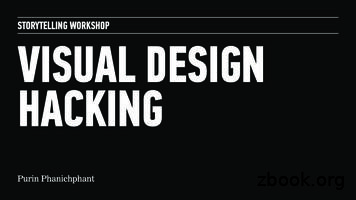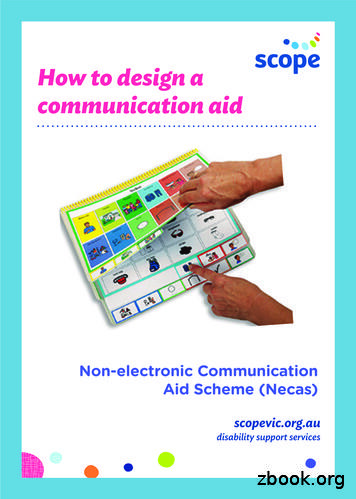VISUAL COMMUNICATION AND DESIGN
Victorian Certificate of Education2009SUPERVISOR TO ATTACH PROCESSING LABEL HERESTUDENT NUMBERLetterFiguresWordsVISUAL COMMUNICATION AND DESIGNWritten examinationTuesday 10 November 2009Reading time: 11.45 am to 12.00 noon (15 minutes)Writing time: 12.00 noon to 1.30 pm (1 hour 30 minutes)QUESTION AND ANSWER BOOKStructure of bookNumber ofquestionsNumber of questionsto be answered88Number ofmarks88 Students are permitted to bring into the examination room: pens, lead and coloured pencils,water-based pens and markers, highlighters, erasers, sharpeners, rulers, set squares, protractors andcompasses. Students are NOT permitted to bring into the examination room: tee-squares and boards, compressedgas sprays, equipment requiring a power source, blank sheets of paper and/or white out liquid/tape. No calculator is allowed in this examination.Materials supplied Question and answer book of 15 pages. Resource book of 10 pages.Instructions Write your student number in the space provided above on this page. All written responses must be in English.At the end of the examination You may keep the resource book.Students are NOT permitted to bring mobile phones and/or any other unauthorised electronicdevices into the examination room. VICTORIAN CURRICULUM AND ASSESSMENT AUTHORITY 2009
2009 VISCOM EXAM2InstructionsAnswer all questions in the spaces provided.Question 1Below are examples of six drawing systems used to produce visual communications. Number the boxes to matcheach drawing system with the correct example shown.1.2.3.A4.A5.6.a two-point perspective drawinga sectional drawinga planometric drawingan oblique drawingan isometric drawinga one-point perspective drawing6 marks
32009 VISCOM EXAMQuestion 2Below are four tonal renderings of objects. Circle the two drawings where tone has been correctly appliedaccording to the light source indicated.a.b.directionof lightdirectionof lightc.d.directionof lightdirectionof light1 1 2 marksTURN OVER
2009 VISCOM EXAM4This page has been left blank for rough working space for development work.Work on this page will not be assessed.
52009 VISCOM EXAMQuestion 3Using the light source indicated, render each shape with tone to enhance its three-dimensional form.directionof lightdirectionof light4 4 8 marksTURN OVER
2009 VISCOM EXAM6Question 4Below is a sketch of a wooden block on a 10 mm isometric grid. On page 7, draw the third-angle orthogonaldrawing of this block using the 10 mm grid given. arrow A indicates the front view include all hidden lines and centre lines according to the Australian Standards Association conventions include all labels and symbols according to the Australian Standards Association conventionsAQuestion 4 continued
72009 VISCOM EXAMComplete your answer to Question 4 in the space below.21 marksTURN OVER
2009 VISCOM EXAM8Question 5Figure 1, on page 3 of the resource book, is a poster for a music concert.You must answer all parts of this question in response to Figure 1.a. Identify the intended purpose of this poster.1 markb.Identify and describe one dominant design element and discuss how it has been used effectively in thisdesign.ElementDiscussion1 2 3 marksc.Choose a dominant design principle which has been used in this poster. Evaluate its effectiveness inconveying information and/or ideas.PrincipleEvaluation1 3 4 marks
92009 VISCOM EXAMQuestion 6Figure 2, on page 4 of the resource book, is a prototype of a cardboard bicycle design. The client required acheap and ecologically friendly form of transport which would encourage commuters to cycle to work ratherthan drive a car.The final design is made entirely from recycled materials. The bicycle is water resistant. It is lightweight andcosts less than 30 to purchase.a. Identify two characteristics of the target audience(s) for the bicycle design.In your response discuss the reason(s) for your decision.2 2 4 marksb.What decisions may the designer have considered in choosing materials during the design process?3 marksTURN OVER
2009 VISCOM EXAM10Question 7In the resource book on pages 5–8 is a series of images showing the design process used by the illustrator FinlayWilliams to produce a set of Christmas cards.The client required five unique designs that needed to work together as a set in black and white a handmade and contemporary feel that would appeal to adults.a. Identify four components of the design process undertaken by Finlay Williams.1.2.3.4.4 marksb.Describe two resources Finlay Williams may have used in the development of his ideas.1.2.2 2 4 marksc.Discuss two methods that Finlay Williams may have used to develop and refine his ideas. In your answerdescribe how he has used each method.Method 1DescriptionMethod 2Description(1 2) (1 2) 6 marksQuestion 7 continued
11d.2009 VISCOM EXAMDescribe how Finlay Williams may have worked together with the following specialists during the designprocess.PrinterGraphic designer3 3 6 marksTURN OVER
2009 VISCOM EXAM12Question 8Shooting Star is a large observation wheel located on the waterfront of a major city. Each of the cabins carriesup to 20 guests on a 30-minute ride. The view from each cabin during the ride provides guests with a panoramicview of the cityscape.You are required to design a ticket that will be used to gain entry for a ride on the Shooting Star observationwheel. The ticket will be for one person. The layout found on page 13 defines the shape of the ticket and mustbe used for your final answer. You may use the answer space horizontally or vertically.In your design you are required to use one or more of the following shapes to create imagery for the ticket.You may change the scale and proportion to suit your design. The shapes may be used in solid form or as anoutline.The design of the ticket must also include the text ‘Shooting Star’, ‘Admit One’ and the cost ‘ 15’ use the element of colour to create the following hierarchy of information (title, images, cost) emphasise the principles of both cropping and pattern.The images provided on pages 9–10 of the resource book may be used as inspiration.(4 2 4) 6 16 marksworking spaceQuestion 8 – continued
Complete your design for Question 8 in the space provided below.132009 VISCOM EXAMTURN OVER
2009 VISCOM EXAM14Rough working space for development workWork on this page will not be assessed.
15Rough working space for development workWork on this page will not be assessed.END OF QUESTION AND ANSWER BOOK2009 VISCOM EXAM
Victorian Certificate of Education2009VISUAL COMMUNICATION AND DESIGNWritten examinationTuesday 10 November 2009Reading time: 11.45 am to 12.00 noon (15 minutes)Writing time: 12.00 noon to 1.30 pm (1 hour 30 minutes)RESOURCE BOOKInstructions A question and answer book is provided with this resource book. Refer to instructions on the front cover of the question and answer book. You may keep this resource book.Students are NOT permitted to bring mobile phones and/or any other unauthorised electronicdevices into the examination room. VICTORIAN CURRICULUM AND ASSESSMENT AUTHORITY 2009
2009 VISCOM RESOURCE BOOK2This page is blank
32009 VISCOM RESOURCE BOOKReference material for Question 5Due to copyright restriction,this material is not supplied.Figure 1TURN OVER
2009 VISCOM RESOURCE BOOK4Reference material for Question 6Citycycle bicycleMaterial: lightweight recycled cardboardCost: under 30Figure 2
52009 VISCOM RESOURCE BOOKReference material for Question 7Due to copyright restriction,this material is not supplied.Question 7 – continuedTURN OVER
2009 VISCOM RESOURCE BOOK6Reference material for Question 7Question 7 – continued
72009 VISCOM RESOURCE BOOKReference material for Question 7Question 7 – continuedTURN OVER
2009 VISCOM RESOURCE BOOK8Reference material for Question 7
92009 VISCOM RESOURCE BOOKReference material for Question 8Images of an observation wheelobservation wheel cabinQuestion 8 – continuedTURN OVER
2009 VISCOM RESOURCE BOOK10Reference material for Question 8END OF RESOURCE BOOK
a two-point perspective drawing a sectional drawing a planometric drawing an oblique drawing an isometric drawing a one-point perspective drawing 6 marks Instructions Answer all questions in the spaces provided. 3 2009 VISCOM EXAM . Shooting Star is a large observation wheel located on the waterfront of
Feb 23, 2012 · STORYTELLING WORKSHOP. VISUAL DESIGN HACKING One Goal: To equip you with simple and actionable techniques to kick ass at visual design. VISUAL DESIGN HACKING VISUAL DESIGN IS AN EXTREMELY VALUABLE SKILL. IT GOES A LONG WAY. VISUAL DESIGN HACKING
What Is Mass Communication? Cultural definition of communication (1975)! James W. Carey: “Communication is a symbolic process whereby reality is produced, maintained, repaired and transformed.”! Carey’s updated definition (1989) asserts that communication and reality are linked. It’s truest purpose is to maintain ever-evolving,File Size: 1MBPage Count: 22Explore furtherIntroduction to Mass Communication: Media Literacy and .www.researchgate.netDownload [PDF] Introduction To Mass Communication eBookardhindie.comIntroduction To Mass Communication 7th Editionicomps.com(PDF) Media And Culture - An Introduction To Mass .www.academia.eduIntroduction to mass communication - Archivearchive.orgRecommended to you b
How to design a communication aid Scope (Vic) Ltd 2015 Communication & Inclusion Resource Centre - 2 - How to design a communication aid This information will assist you to design a non-electronic communication aid. Communication aids provide a method of communication for people wh
social development. Visual processing refers to a group of skills used for interpreting and understanding visual information. The evaluation may include testing for visual spatial orientation skills, visual analysis skills, including auditory-visual integration, visual-motor integration skills and rapid naming.
Visual Basic, VBA (Visual Basic for Applications), and VBScript (Visual Basic Script) Visual C, Visual C , and other versions of C for Windows Java, Visual J , Visual J#, JavaScript, and JScript Any language for which there is an ActiveX
recognizing state shapes, completing shapes, and identifying incongruities in pictures. Following are the seven areas with the number of lessons given in parenthesis: visual motor (113), visual reception (37),visual discrimination (29), visual memory (48) visual sequential memory (49), visual closure (30), and visual association (24).
Visual Basic - Chapter 2 Mohammad Shokoohi * Adopted from An Introduction to Programming Using Visual Basic 2010, Schneider. 2 Chapter 2 –Visual Basic, Controls, and Events 2.1 An Introduction to Visual Basic 2.2 Visual Basic Controls 2.3 Visual Basic Events. 3 2.1 An Introduction to
Visual Basic 6.0 versus Other Versions of Visual Basic The original Visual Basic for DOS and Visual Basic F or Windows were introduced in 1991. Visual Basic 3.0 (a vast improvement over previous versions) was released in 1993. Visual Basic 4.0 released in late 1995 (added 32 bit application support).























